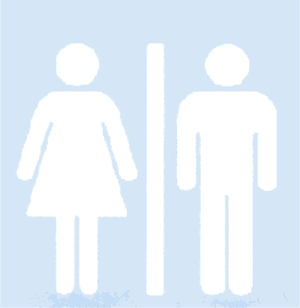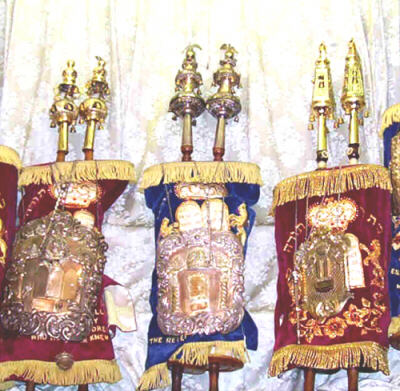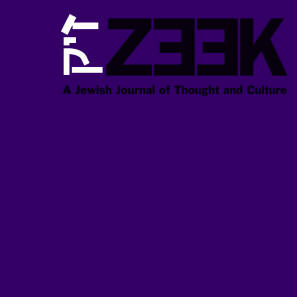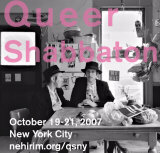 May 06
May 06
Aliyah: Trans(Per)forming Jewish Ritual
by Luke Dzmura
p. 2 of 2
 A gaping faultline exists in our tradition along the boundary of the invisible mechiza we find even in the most liberal reform shul, and we wonder that attendance is going down. We can binarize ourselves right out of existence. There’s a man with a vagina in the men’s room. And he belongs there. Authenticity requires that all our disjointed narratives be declared in the central myth, all our selves ritualized.
A gaping faultline exists in our tradition along the boundary of the invisible mechiza we find even in the most liberal reform shul, and we wonder that attendance is going down. We can binarize ourselves right out of existence. There’s a man with a vagina in the men’s room. And he belongs there. Authenticity requires that all our disjointed narratives be declared in the central myth, all our selves ritualized.
I want my shul to build a good case for the inclusive Judaism it preaches but doesn’t practice. I want to be able to trace that lineage myself as if I were following the logic of a resolved proof, not just assume its presence. And I want to share that story with the liberal Jews of my congregation, so that I might participate equally in the social life of my shul as a gay transgender man. The lesson of that inclusivity must also come from the bimah in order to penetrate to the bubbes and the straight congregants who, all unknowing, invite a transman to Shabbat dinner. And we can put a label on the shul door that says EVERYBODY.
It’s not going to happen today or tomorrow. But next year, maybe, in Berkeley.
III. In the Sancturary: Redemption
When I enter the sanctuary, I do not even have time to put on my tallit. You’re serving as gabbai today and you are shaking my hand, asking me if I would like to take an aliyah. I thank you for the honor, but decline with visible embarrassment, saying that my Hebrew is not up to snuff. (Liar!)
I walk to a seat in the back and say the blessing before putting on my tallit. When we come to the Torah reading, I start to contemplate my refusal to take an aliyah. As a Jewish transman, I find the public restroom stretches into the sanctuary. There are roles for men, roles for women, but none for me. Like a post-modern Fiddler on the Roof, I am balancing on the mechiza.
Aliyah is a Hebrew word meaning “to go up.” To “take an aliyah” is to go up to the bimah and say the blessings before and after a Torah portion is read; any role in the Torah service is an honor, but an aliyah is one of the highest. When one takes an aliyah, one is ‘going up’ to the bimah, but one is also making a spiritual ascent. In an Orthodox congregation, men perform this service. In a more liberal congregation, a woman may as well.
[I have declined every invitation extended by a gabbai to take an aliyah, or I have intentionally arrived late to services so I wouldn’t be asked. Why? At first there seemed to be four reasons: performance, process, parents, and pronoun. That is, performance anxiety (even persons who are well acquainted with the ritual may freeze like a deer in the headlights when it is their time to perform), the procedural mechanics or choreography of the ritual itself, the naming of parents (I don't always feel comfortable "outing" myself as a convert), and the traditional use of “the pronoun” (ben or bat; not exactly pronouns, but words meaning son or daughter) when the gabbai calls out the name of the individual honored with an aliyah; if a transgender person identifies as male but still looks significantly female, (or vice versa), the gabbai might use the wrong pronoun.
But I eventually realized that I am not burdened with any of these anxieties. So why have I declined this honor?

It took me a long time to figure this out as I converted to Judaism, but it’s about sex. I have the same anxiety about taking an aliyah that I have about making love with a new partner. On the surface, the Torah service is dignified and wholly sacred. Just below the surface, though, it’s all about sex: public, communal, ritualized, sacred sex. The hieros gamos, the sacred marriage. And when you’re talking about sex, gender matters on a much deeper level than a simple pronoun.
The Torah is fully dressed when She is tenderly embraced and lifted from the Aron ha Kodesh (commonly, ‘the Ark of the Covenant’). The congregation stands when the Torah—in other guises, the Shechinah, the Sabbath Queen—is displayed in all her finery. She is laid down on a table and reverently undressed: Her fine garments and adornments (various ornate coverings, the crowns on the scroll handles, and a binding cord) are removed and set aside. To stand in the presence of the naked Torah scroll is to be intimate with a body: the Torah is the Covenant made flesh, a body with literal skin, physical weight, and an undeniable Presence. It is easy to see Her as the embodiment of the Shechinah. Her “life” is every Jewish life that was and will be. God’s word is inscribed on Her flesh. As Jews we are instructed to love what She represents uvechol levavcha, uvechol nafshecha, uvechol meodecha, “with all of our heart, all of our soul, and all of everything else that is ours.” “All”—all in that last clause means our bodies, even the parts of our bodies we use to connect intimately with other humans.
Over the course of the year, those who stand in front of the Torah view every inch of Her flesh, their fingers in voyeuristic proximity but never touching her delicate skin. Those who stand in front of the Torah watch the slow and deliberate revelation of every last one of Her secrets; yet every following year She can still surprise and delight—like an old lover with newly acquired expertise. As is common to secular public sex functions, there is a person whose job it is to see that she is not violated when She lies thus exposed—that person instantly corrects when an error is made. This long foreplay is a tantalizing nearness that stimulates desire.
What is penetrating? Who is being penetrated? Of course, we make love to words and ideas through stories and layered meanings, but the deeper meaning of the ritual in traditional Judaism is that God is the Bridegroom, Torah is the ketubah (marriage contract), and Israel is the Bride. God and Israel come to union through the Scroll. The reader, the congregants, the oleh hatorah, the gabbai—all of these who interact with the scroll represent Israel, the Bride. The ritual was designed to facilitate a sacred union between a male God and male humans without the onus of homosexuality. Men, feminized (transgendered) through their union with the Torah, may through a mystical understanding of the same activity, become God’s lovers without shame.
Queers, women and transgender persons take aliyot in liberal congregations: any adult may be called up to the Torah, and the master story of the Divine Feminine sails under the radar for most people. We are so far removed from the sources of our rituals that the deep meanings can be lost to us; maybe part of why shul attendance has dropped for all denominations (except perhaps the Orthodox) is because we can’t connect what we do in shul with Divine Union, or Sacred Sex. But for me, my gender identity will go up to the Torah with me when I finally have the courage to take an aliyah. And when we meet, the Scroll will present a male torso to me, and with no shame will present a male backside to God. That’s what authenticity requires; the tradition can require no less. The Torah must become a Man for a man with female genitals. I am asking God’s Chosen to step with me into a master story where queer no longer signifies same-sex-genitals interacting, where the Torah is not just an incubator for ‘the white’ (to use the Rabbinic euphemism) of two heterosexual men, but rather where the Scroll is recognized –even though it sounds like a piece of plumbing hardware—as a kind of universal connector between all Jews and God.
My Judaism is lived between the leaves of my Siddur (prayer book), enclosed within the walls of my apartment, and in the company of Jews so liberal and tolerant that “anything goes,” or so unschooled that I know more of the tradition than they do. Because of my reluctance to meet God publicly in such an intimate and public encounter as an aliyah, my Judaism has been limited: cut off from the source of communal life; limited to the space behind the closed door of a bathroom stall; “closeted.”
Most Jews I know are unaware of, or unconcerned with, the master story that makes Judaism heterosexist, gender normative and homophobic, but we have to pay attention to our mythos. It’s the origin of the faultline in our communities. Time to tell a new, more nuanced set of myths. When the tradition invites re-reading, as it so clearly does, it is amazing to me how few people step up to the plate. Feminists have started to read through a feminist lens. Queers are starting to. And now, transgender persons. The wellspring of that master story holds something in it for me and my Jewish transgender brethren (and sisteren and otheren), something that was set there back when the Universe was created. It is our job to seek it out, uncover it, and share the revelation. Where it can’t support us, we can build a “traditionally non-traditional” scaffold.
In an inclusive Jewish world, God’s intimacy with Torah and His Peoples’ intimacy with Torah connect, embrace, make love, through the transgendering body of the Scroll. There is a pagan element, a Kabbalist’s mystery that suffuses my Torah: S/he is a shape-shifter, the object that connects the world above to the world below, the mediator of a universal Jewish coupling.
Luke Dzmura recently completed his M.A. at the Richard S. Dinner Center for Jewish Studies of the Graduate Theological Union (GTU) in Berkeley, CA; his thesis is entitled "Textual Relations in the Restroom: Countering Inauthenticity in Jewish Transgender Lives." A recipient of the Haas-Koshland Award, Mr. Dzmura will be studying at Pardes Institute for Jewish Studies in Jerusalem in 2006-07. He invites responses to be sent to brerrabbi@hotmail.com.










